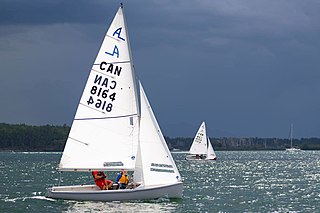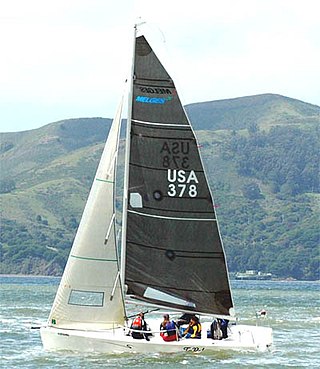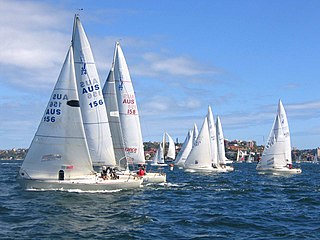
Yacht racing is a sailing sport involving sailing yachts and larger sailboats, as distinguished from dinghy racing, which involves open boats. It is composed of multiple yachts, in direct competition, racing around a course marked by buoys or other fixed navigational devices or racing longer distances across open water from point-to-point. It can involve a series of races with buoy racing or multiple legs when point-to-point racing.

Dinghy racing is a competitive sport using dinghies, which are small boats which may be rowboats, have an outboard motor, or be sailing dinghies. Dinghy racing has affected aspects of the modern sailing dinghy, including hull design, sail materials and sailplan, and techniques such as planing and trapezing.

The Albacore is a 4.57 m (15 ft) two-person planing dinghy with fractional sloop rig, for competitive racing and lake and near-inshore day sailing. Hulls are made of either wood or fiberglass. The basic shape was developed in 1954 from an Uffa Fox design, the Swordfish. Recent boats retain the same classic dimensions, and use modern materials and modern control systems.
The Portsmouth Yardstick (PY) or Portsmouth handicap scheme is a term used for a number of related systems of empirical handicapping used primarily in small sailboat racing.
The Ross 930 is a class of fast cruiser-racer yachts named after its designer, New Zealander Murray Ross. The design is marked by light weight and moderate sail area, with a sail-area-to-displacement (SA/D) ratio of about 24, and displacement-to-length (D/L) ratio of 98. The bow section is quite narrow, providing relatively low wave-making resistance and reducing pounding while sailing upwind in waves, and the stern section is wide and flat, making the boat easy to control sailing fast downwind. The interior of the Ross 930 is comfortable, including fitted berths for five, a two-burner stove, galley with sink, and a head. The standard engine is an outboard in a well, but a few boats were built with small inboard diesel engines.
One-design racing is a racing method which may be adopted in sports using complex equipment, whereby all vehicles have identical or very similar designs or models, avoiding the need for a handicap system.
The International Offshore Rule (IOR) was a measurement rule for racing sailboats. The IOR evolved from the Cruising Club of America (CCA) rule for racer/cruisers and the Royal Ocean Racing Club (RORC) rule.

The International rule, also known as the Metre rule, was created for the measuring and rating of yachts to allow different designs of yacht to race together under a handicap system. Prior to the ratification of the International rule in 1907, countries raced yachts under their own national rules and international competition was always subject to various forms of subjective handicapping.

The Nepean Sailing Club (NSC) is a sailing club located on Lac Deschênes in Ottawa, Ontario, Canada. The club is based in Dick Bell Park, along Carling Avenue, adjacent to Andrew Haydon Park in the former city of Nepean.

Farr Yacht Design, founded by Bruce Farr in Auckland, New Zealand, is a racing yacht design firm based in Annapolis, Maryland, United States. The firm is led by Patrick Shaughnessy. Its yachts measure from 25 feet (7.6 m) to 125 feet (38 m). Farr develops custom and production yachts, including interiors, sails, and hull design. Farr uses outside research and development with tank testing and wind tunnels. Farr-designed yachts have won and placed well in a broad range of races.
This article attempts to give an overview of the design and manufacturing of sailboats and the evolution of this industry. Details should be found and contributed through linked articles.

The Olson 30 is a sailboat designed by George Olson of Santa Cruz, CA around 1978. Olson was a surfer and surfboard shaper who decided to design a 30' ultra light displacement boat while on a delivery from Honolulu to Santa Cruz on Merlin, a 68' Bill Lee designed and built ultralight sailboat which had competed in the biennial Transpac race in 1977. During this delivery, Olson came up with the idea while sailing with Denis Bassano and Don Snyder, who lent their initials to the prototype's name, SOB 30. The resulting boat was christened Pacific High, and it was launched in 1978.

A sailing yacht, is a leisure craft that uses sails as its primary means of propulsion. A yacht may be a sail or power vessel used for pleasure, cruising, or racing. There is no standard definition, so the term applies here to sailing vessels that have a cabin with amenities that accommodate overnight use. To be termed a "yacht", as opposed to a "boat", such a vessel is likely to be at least 33 feet (10 m) in length and have been judged to have good aesthetic qualities. Sailboats that do not accommodate overnight use or are smaller than 30 feet (9.1 m) are not universally called yachts. Sailing yachts in excess of 130 feet (40 m) are generally considered to be superyachts.

The term sportsboat first appeared in the late 1980s and early 1990s to describe trailer sailers that were optimised for high performance at the expense of accommodation and ballast. The very definition of the term "sportsboat" is evolving.
The Seaway 25 was designed by Doug Peterson of USA fame for Tom Stevenson in 1978 after Tom won the World half Ton championship in one of Doug's designs. The yacht was designed to sail well on the short sharp chop of Port Phillip Bay Melbourne Australia. Intended to rate as a quarter ton Trailer yacht under IOR and Junior Offshore Group racing both for Harbour and Inshore Yacht racing.
A velocity prediction program (VPP) is a computer program which solves for the performance of a sailing yacht in various wind conditions by balancing hull and sail forces. VPPs are used by yacht designers, boat builders, model testers, sailors, sailmakers, also America's Cup teams, to predict the performance of a sailboat before it has been built or prior to major modifications.

The sport of sailing involves a variety of competitive sailing formats that are sanctioned through various sailing federations and yacht clubs. Racing disciplines include matches within a fleet of sailing craft, between a pair thereof or among teams. Additionally, there are specialized competitions that include setting speed records. Racing formats include both closed courses and point-to-point contests; they may be in sheltered waters, coast-wise or on the open ocean. Most competitions are held within defined classes or ratings that either entail one type of sailing craft to ensure a contest primarily of skill or rating the sailing craft to create classifications or handicaps.
Handicap forms for sailing vessels in sailing races have varied throughout history, and they also vary by country, and by sailing organisation. Sailing handicap standards exist internationally, nationally, and within individual sailing clubs.

The C&C 37/40 is a Canadian 12.05 metres (39.5 ft) LOA fibreglass monohull sailing yacht, designed in 1988 by Robert W. Ball of Cuthbertson & Cassian as a replacement for the earlier C&C 37 dating from 1981. The C&C 37/40 is a recreational keelboat of moderate displacement, intended as a cruiser/racer or oceangoing racer. The yachts have a masthead sloop rig, with a fin keel and an internally-mounted spade-type rudder. Over 110 of the 37/40 type were built before the Canadian plant closed in 1994. The design is no longer produced.
The Newport 28-2 is an American sailboat that was designed by C&C Design as a cruiser-racer and first built in 1982.










